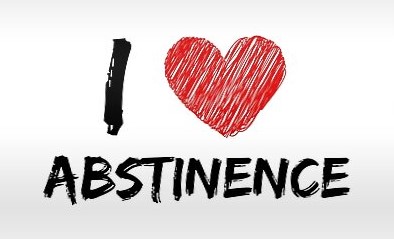EXPANDED EDITION
Accounting – Yom Yirusholayim- Pedigree Day– Abstinence, and More.
Raboyseyee and Ladies,
Let’s begin here: For the past 39 years, the heylige Ois has enjoyed, and so continues, a very close relationship with Rabbi Benjamin Blech with whom he speaks kimat daily. The good rabbi needs no introduction, but a few words are appropriate. The rabbi is a professor of Talmud at Yeshiva University since 1966, was the rabbi of Young Israel of oceanside for 37 years, has written a whopping 23 books on Judaism and the Jewish People, and speaks on Jewish topics to communities around the world. He is the man! He is also the inspiration for the Ois to begin reducing his thoughts to writing.

In honor of Yom Yirusholayim (celebrated this past Sunday), and the upcoming Yom Tov of Shovuis, when we will be reading the Aseres Hadibros, the heylige Ois asked the good rabbi -and the good rabbi agreed- to record a shtikel Devar-Toirah, which can be found here. It’s givaldig!
Shoin, in case you’re wondering why Sefer Bamidbar, which recounts the travails of the Yiddin during their 40-year sojourn through the midbar, is known as The Book of Numbers, a name that doesn’t epes translate from Hebrew to English properly, let the Ois explain. It’s poshit: Avada you know that Bamidbar begins with a count, a census of the Yiddin. Chazal (our sages) referred to the fourth book of the Toirah as Sefer HaPikudim, The Book Of Counting. Gishmak and simple. So happens that the Yiddin will be counted again later in this very book of numbers. Parshas Bamidbar contains none of the taryag (613) mitzvis and other than counting, flag decorating, and marching formations, not much else going on this week. Even Rashi, who opines quite often and takes notice of nuance, has little to say this week. Ober not to worry because as we make our way through Bamidbar there will plenty to discuss -by Rashi and many others- as the Yiddin committed many chatoim (sins) during their midbar stint; stay tuned! The parsha opens with the RBSO’s command that a census be taken of the Yiddin, the first of three such counts taken in the first thirteen months following the Exodus from Mitzrayim. As to why the RBSO wanted the Yiddin counted, why three counts in such close succession, and the differences between them, ver veyst? Of-course this caught the attention of Rashi who suggests that the RBSO counted the Yiddin because He loved them. “Because they (the Children of Israel) are dear to Him, He counts them all the time. When they went forth from Egypt, He counted them; when they fell because of (the sin of) the Eygel (Golden Calf), He counted them; when He was about to make His presence dwell amongst them (i.e., in the Tabernacle) He counted them. For on the first of Nissan the Tabernacle was erected, and on the first of Iyar (the next month) He counted them.” Seemingly this love fest didn’t last all that long. It so happens that kimat all the Yiddin counted in the first and second census will have perished by the fortieth year just before entry to the land. Perhaps Rashi meant ‘tough love’, ver veyst. Bottom line: The RBSO ordered a count and that’s what Moishe, Aharoin and their 12 assistants did.
Mistama you forgot -or never knew- that Parshas Bamidbar is always read just before Shovuis and so says the Shulchan Aruch, Oirach Chaim (428:4). All over? Not in Israel of course where they remain one parsha ahead for the next three months. How was this arranged so perfectly? Our chachomim (sages) designed the cycle of weekly readings to ensure this order, ober why taka? Says Toisfis, (Megillah31b) azoy: chazal (another word for sages) wanted to “buffer” last week’s parsha which contained dire warnings for the wayward bunch of Yiddin who had just left Mitzrayim weeks earlier (just under seven), and the “Yoim HaDin” of Shovuis. Hey, isn’t Yoim Hadin, another name for Yom Kippur? It is! What’s it doing here in late May early June on Erev Shovuis mamish when we’re about to celebrate the great big wedding between the Yiddin and the RBSO with cheesecake? What’s pshat? Shouldn’t we be celebrating the anniversary with wedding cake? How and why is Shovuis considered a day of judgement? Answers the heylige Gemora azoy: on Shovuis the RBSO determines yield -an accounting term: not of humans, but of fruit trees. Says the heylige Gemora (Rosh HaShono 16a): on Shovuis, the RBSO decides the yield of fruit trees for the coming year. And how is the fruit tree connected to the parsha and Shovuis? Nu, halt kup: the answer goes azoy: by placing Parshas Bamidbar between the toichocho of last week to Shovuis this week, we metaphorically say to the RBSO that “the curses He had in mind, should apply to the previous year’s fruit crop and not affect the coming year.” Why the poor innocent fruit tree needs to suffer for our behavior, ver veyst, but that’s what is says. Then again, most animal sacrifices are also related to our sins. Our job is to believe. Bottom line: Parshas Bamidbar acts as the stop gap between Bechukoisai and Shovuis to avoid any mention of our misdeeds, (of which, by this time of year -and any other time- there are plenty) at this critical time when the bounty of our trees and so much of our material well-being is being determined. Got all that? Not? You’re not alone.

Speaking of an accounting, the seedlings of a major source of parnoso (income) and a sought-after profession for many Yiddin throughout the millennia has its roots right here in our parsha. Moishe was seemingly the first ever Jewish accountant and auditor. His first assignment dates back to the full accounting he gave regarding all the donations collected for the Mishkan project. One medrish tells us that the Yiddin accused Moishe of theft until the RBSO vouched for his honesty. In the end, it was but an accounting error. His next assignment was to count all the Jews several times. As the parsha opens, Moishe is charged with conducting a second count. As mentioned, aside from the census which is described in great detail with much repetition, and which consumes the entire parsha, Bamidbar contains very little other content. What to discuss this week? Let’s try the upcoming chag of Shovuis.
Mistama you never knew -or certainly long forgot- that the date of the giving of the heylige Toirah is not stated explicitly in the heylige Toirah, and its connection with the chag (festival) of Shovuis is not perfectly clear. What? There’s more: Even Shovuis itself has no fixed date in the heylige Toirah. It doesn’t? Is the Ois brazenly stating that yearly we celebrate Revelation (Matan Toirah) -our wedding anniversary mamish- on a date certain, on Shovuis, yet we are not even certain exactly when Shovuis is? Exactly! Well blow me down? And if that’s the case, why can’t we move it around from year to year to avoid a three-day yom tov and food binging festival? Let’s get real: kimat all women and most men would pay a hefty price to lose that shabbis just before or after. Let’s get real: we need that 3rd day like a luch-in-kup (lit: hole in the head). What’s taka pshat? Shoin, what we know with certainty is this: Shovuis falls fifty days after the 16th of Nissan, the day of the Omer offering, and may therefore occur on different dates depending on whether the months of Nissan and Iyar are full (30 days) or not (29 days). Confused? Again, you are not alone. The questions stand: if Shovuis is not fixed in the heylige Toirah, let’s show some flexibility. Would more or fewer chose to book a hotel for Shovuis were it but a two-day yom tov?
Says the author of “Seder Olom” (which is accepted in all the relevant sugyos in the heylige Gemora) that the 10th of Nissan in Mitzrayim was Shabbis Ha-Gadol, the 16th of Nissan was a Friday, and the Toirah was given on the heylige shabbis. Hence, Matan Toirah was actually the fifty-first day after the offering of the Omer, and not on Shovuis. Say it’s not so but them are the facts; Yikes! The heylige Gemora (Shabbis 86a-88a) addresses the question of which day of the month the Toirah was given on at length. Says Reb Yossi azoy: it was given on the 7th of Sivan, ober the chachomim (wise rabbis) argue that the Toirah was given on the 6th of Sivan. Both opinions agree that the “three days of preparation” began on the 4th of Sivan, but the Tana’im of the heylige Gemora debate whether what actually happened was in accordance with the RBSO’s statement – “For on the third day G-d will descend before the eyes of all the nation onto Mt. Sinai” (Shmois 19:11), i.e., on the 6th of Sivan – or in accordance with Moishe’s statement: “Prepare yourselves for three days” (19:15) – i.e., the 7th of Sivan. Confusing?
Three days of preparation? What’s that? How did one prepare for Revelation? What went down during these three days? Seemingly not much and no one, if you chap, because among the instructions Moishe gave was that men should separate from women. And by women he meant their neshei chayil’ (wives); presumably all others as well. Shoin! As an aside, much is written about Moishe’s separation from his own wife and how he never again went back to his martial obligations of pleasuring her; yikes! As it turned out many wives were pleased with such separation and extended the practice for weeks and even months. Oy! That discussion for an upcoming shabbis -in a few weeks- where this topic will be fully expanded and expounded upon. More on the topic of separation below. There’s also a whole lot more written on the main topic of when Yom Tov was and is, ober the bottom line is azoy: despite Talmudic debates which were never resolved -yet another case for Eliyahu to clarify- and no matter how you feel about the differing positions, brace yourselves for a three-day yom tov as shabbis approaches; fartig! The matter remains in limbo until Moshiach arrives and gets the entire calendar back into working order as the RBSO intended and expressly-or not- stated in the heylige Toirah. Another bottom line: those who sell cheesecake and other dairy products – items which have mysteriously become associated with Shovuis – also needed their day in the sun. Toirah inspired entrepreneurs, who mistama formed the very first dairy association lobby, found a connection -albeit quite a loose one -if that- and shoin: more dairy products are sold and consumed for this yom tov than the entire nine days combined when meat is forbidden. How is that possible?

Let us not forget the power of the sium which has magical powers to dispense with rules instituted by our sages on meat restrictions. That too for another time. Ober this year, with shabbis added to the mix, many will look to adding one more dairy meal to their menus. Why taka do we eat dairy products on Yom tov? Weren’t we taught that shabbis and yom tov meals require chicken and or meat? Weren’t we taught that there is no simcha but only with meat? We were! Let’s read that innaveynig. Says the Rambam (Mishneh Toirah Rest on Holidays 6:18) azoy: (יח) …וְהָאֲנָשִׁים אוֹכְלִין בָּשָׂר וְשׁוֹתִין יַיִן שֶׁאֵין שִׂמְחָה אֶלָּא בְּבָשָׂר וְאֵין שִׂמְחָה אֶלָּא בְּיַיִן.
(18) …the menfolk should eat meat and drink wine, for there is no real rejoicing without the use of meat and wine. There’s more and let’s check out this from the heylige Gemora (Pesochim 109a):
“It was taught: R’ Yehuda b. Beseira says. “While the Temple is standing, there is no joy unless there is meat, as it says (Devorim 27) ‘And you shall sacrifice peace-offerings and eat them there, and you will be joyful before the Lord, your G-d’. Now that the Temple is not standing, there is no joy without wine, as it says (Psalms 104) ‘ And wine will rejoice the heart of man.'”
Ober the shaylos (questions) are azoy: it’s taka emes that the quoted shtikel says what is says, ober is this valid in post temple times? Moreover, the breisa is oft-misquoted and rarely understood. Every meat-and-booze-loving yeshiva bachur can quote ‘ein simcha ella be-bosor ve-yayin’ – there is no joy without meat and wine, ober the passage as normally quoted doesn’t exist in the heylige Gemora. Bottom line: while Yiddin may have forgotten about the Beis Hamikdash -and mourn for it only on Tishe Be’Av- they have not forgotten about eating wine and meat. Another bottom line: dairy meals have made inroads into our yom tov menus. How taka did dairy creep into the menu? The Ois admits to not being able to find any real credible sources for this custom. Mistama -and as mentioned above- this minhag came about as do many others in the frum world because back in the year 2448, a few Toirah inspired entrepreneurs found a way to outlaw the dishes and pots the Yiddin were using while in the midbar. We call that gorilla marketing but it seems to have taken hold. One medrish suggests that the Yiddin, upon receiving the Toirah, could not eat any of their meat products because the meat they had was not prepared in accordance with the newly given shechita laws (ritual animal slaughter) and other dietary restrictions. Once the heylige Toirah was given, the Yiddin refrained from eating meat because they now needed to learn the laws of kosher slaughter and to avada kasher their utensils in the mikveh. Where they found a mikveh in the Midbar, ver veyst, but as discussed in the past, the Midbar was a magical place. If the RBSO wanted a mikveh to suddenly appear so that the good Yiddin could toivel their equipment, if you chap, and their utensils, is that so hard to believe? Ober before the magical mikveh appeared, what to do and what to eat? Nu, they improvised and ate milichiks (dairy) while studying these new kosher concepts. And so it happened that on Shovuis, the great holiday when we celebrate receiving the heylige Toirah, they ate cheesecake, blintzes, ice cream, pizza and other such delicacies. In later years, they added a sushi option. Emes? Ver veyst? On the other hand, didn’t we learn that the Yiddin ate Munn for 40 years in the midbar? Indeed we did. Maybe the munn tasted like pizza, ver veyst?
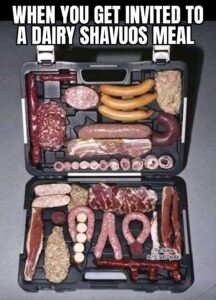
On a more mystical level, the gematria (numeric value of the Hebrew letters) of the word for milk- cholov- is 40 and avada forty corresponds to the forty days and nights that Moishe spent up on the mountain learning the heylige Toirah. Shoin! And now you know. And for the lactose intolerant? Thank the RBSO that this year’s offerings also include non-dairy vegan options.
Final bottom line on this subject is azoy: our sages discussed, argued and presented various opinions on exactly when the RBSO came down and delivered the Aseres Hadibrois. As an aside, according to many, the Yiddin became frightened when the RBSO’s metaphorical voice was heard and Moishe took over and delivered the last eight of them. Many more pages can be dedicated to the various opinions, those for another time.
Let’s instead go back to yesterday when most did not celebrate a yom tov most never heard of. Yesterday was mamish yom tov? We speak not of Yom Yirusholayim which was celebrated this past Sunday, not Rosh Choidesh Sivan marked on Tuesday, but of a holiday seemingly lost. Yom what? If you asked, it’s likely the case that you did not know that yesterday -the second of Sivan- was a Jewish holiday. Mamish? Let’s pause for a moment and wish each other a belated good yom tov. Ober, aren’t we epes jumping the gun by wishing each other a gittin yom tov three days early? Doesn’t Shovuis, the holiday we celebrate because the Yiddin received the heylige Toirah and got married to the RBSO, begin this year only when shabbis is over? It does but, let’s meet Yom HaMiuchas (literally – the day of lineage or Pedigree Day). What is it?

Ver veyst, ober we know that the word miuchas means a proper pedigree and pshat is that a person who has good yichus is a person who has descended from proper and important lineage. Never heard of it? Guess what. Not many did; even those who epes remember hearing something cannot recall what it is they heard, much less anything about the day; clueless mamish. Just last shabbis, the Ois asked three people, all somewhat knowledgeable, what this day was: not a one knew. Exactly why this day is not celebrated, ver veyst, ober leave it to the Ois to dig up the origins of this givaldige day. The bigger surprise might be why Toirah entrepreneurs haven’t yet found ways to commercially exploit this holiday; such a day cannot be far off. Lommer lernin. Ershtens, it’s a real holiday; here are the facts. It all started on the 2nd day of Sivan in the year 2448, mamish a few days before Matan Toirah. Seemingly, what really took place chronologically went down like this. On the First of Sivan, the RBSO instructed Moishe to tell the nation, “You shall be a Kingdom of Priests and a Holy Nation” (Shmois 19:6) – the RBSO informed us that we Yiddin were selected to be His chosen people. On the Second Day of Sivan, Moishe delivered this message and the soon-to-be Yiddin answered azoy: “Everything that the RBSO has commanded we will do” (Shmois 19:8). That day of acceptance of the Toirah by the People -though there was no Toirah quite yet- was given the title “Yom HaMiuchas or Day of Distinction.” That’s it. Want more color?
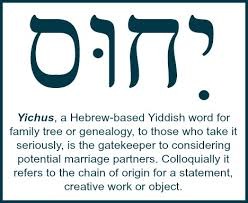
On Rosh Choidesh Sivan (two days ago), the about-to-married Yiddin arrived at the foot of Har Sinai. The purpose of creation was about to be fulfilled with the great seminal event; the Yiddin were about to receive and accept the heylige Toirah. On the second day of Sivan they were informed that their acceptance of the Toirah would elevate them to become the ‘Chosen Nation’. Says the heylige Toirah: (Shmois 19:1-8) azoy: “In the third month from the Exodus of Klal Yisroel from Egypt, on this day, they arrived at the Wilderness of Sinai. They journeyed from Rephidim and arrived at the Wilderness of Sinai and encamped in the Wilderness; and Yisroel encamped there, opposite the mountain. Moishe ascended to Hashem, and Hashem called to him from the mountain, saying, “So you shall say to the House of Yaakov and relate to the Children of Yisroel. You have seen what I did to Mitzrayim, and that I have borne you on the wings of eagles and brought you to me. And now, if you hearken well to Me and observe My covenant, you shall be to Me the most beloved treasures of all peoples, for the entire world is Mine. And you shall be to me a kingdom of ministers and a holy nation. These are the words that you shall speak to the Children of Yisrael.” Moishe came and summoned the elders of the people and put before them all these words that Hashem commanded him. The entire people responded together and said, we’re in! Veyter!
Yoim HaMiuchas coincides always with the forty-sixth day of the Sefiras Ho’oimer. For many of you, sadly this means nothing because you stopped counting with a brocho by the third or fourth night and without a brocho just a few days later. As mentioned, this day is always marked on the second day of Sivan, which happens to be one day before the beginning of the Shloishes Yemei Hagbolo (the three days of restraint). What are those you ask? Halt kup (pay attention) please. Efsher you recall that Moishe instructed the almost-ready-for-prime-time Yiddin that they needed to restrain themselves from relations and intimacy (at home too) during the three days leading up to big day when the RBSO came down and gave us the heylige Toirah. More specifically, they were commanded that beginning on the third of Sivan to physically and spiritually prepare themselves to receive the heylige Toirah. Efsher you’re wondering why abstinence during these three days was mamish a critical component leading up to the big event. Is intimacy with the eishes chayil epes a dirty zach (act)? Not always enjoyable, nu, dus farshteytzich (it’s a given), ober impure? Seemingly it is, or was the case because Moishe specifically told the people that he wanted them to be pure on that special day (Matan Toirah day) and purity included abstinence. Ober seriously, isn’t sex with the eishes chayil a mitzvah? It is! Ober it does epes appear that the semen may (does) cause impurity. Mamish? Let’s check the heylige Gemora which dedicates two full folios to this very topic. Because space is limited, we shall provide but the overview; feel free to check out the Gemora (Shabbis 86a – 88a); it’s explosive, if you chap.
Asks the heylige Mishneh azoy: From where is it derived that a woman who discharges semen even on the third day after relations is ritually impure, just like one who touches semen? Because the semen remains fit for insemination, it can transmit impurity, as it is stated prior to the revelation at Sinai: “And he said to the people, prepare yourselves for three days, do not approach a woman” (Shmois 19:15). This three-day separation period ensured that even a woman who discharged semen would be pure. Got that!
And now some -but zicher not all- the Gemora: The Rabbis said this before Rav Pappa, and some say that Rav Pappa said this to Rava: Granted, Rabbi Elazar ben Azarya holds in accordance with the opinion of the Rabbis, who say with regard to the revelation at Sinai that Moishe instituted separation between husbands and wives on the fifth day of the week. Since everyone agrees that the Toirah was given on Shabbis, husbands and wives were separated for two days. And Rabbi Yishmael holds in accordance with the opinion of Rabbi Yosi, who said that Moishe instituted separation on the fourth day of the week, meaning that husbands and wives were separated for three days. Were they to be separated for two, or three days? The bottom line is azoy: The heylige Gemora goes back and forth on the timing and Moishe’s instructions for separation concludes with this explosive piece.
אָמַר לְךָ רַבִּי יוֹסֵי: יוֹם אֶחָד הוֹסִיף מֹשֶׁה מִדַּעְתּוֹ. דְּתַנְיָא: שְׁלֹשָׁה דְּבָרִים עָשָׂה מֹשֶׁה מִדַּעְתּוֹ, וְהִסְכִּים הַקָּדוֹשׁ בָּרוּךְ הוּא עִמּוֹ. הוֹסִיף יוֹם אֶחָד מִדַּעְתּוֹ, וּפֵירַשׁ מִן הָאִשָּׁה, וְשָׁבַר אֶת הַלּוּחוֹת.
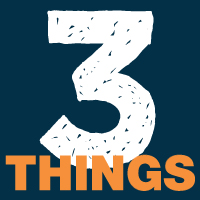 Rabbi Yosi could have said to you: Moishe added one day to the number of days that the RBSO commanded based on his own perception, as it was taught in a breisa: Moishe did three things based on his own perception, and the Holy One, Blessed be He, agreed with him. He added one day to the days of separation before the revelation at Sinai based on his own perception. And he totally separated from his wife after the revelation at Sinai. And he broke the tablets following the sin of the Golden Calf.
Rabbi Yosi could have said to you: Moishe added one day to the number of days that the RBSO commanded based on his own perception, as it was taught in a breisa: Moishe did three things based on his own perception, and the Holy One, Blessed be He, agreed with him. He added one day to the days of separation before the revelation at Sinai based on his own perception. And he totally separated from his wife after the revelation at Sinai. And he broke the tablets following the sin of the Golden Calf.
And when was that day? Nu, believe it or not, it’s epes not clear. As mentioned above, Rav Yosi states that occurred on the 7th day of Sivan (only for this first Shavous), ober says one Tannaitic opinion that it was on the 6th of Sivan. Shoin!
Let’s conclude with this: did anything really happen on this day that we now call Yom HaMuchas? Seemingly not and believe it or not, all seem to agree that mamish nothing took place on this date. In other words, the 2nd of Sivan really has no merit on its own. And if that’s taka the case, why does it have a special name and what’s taka pshat here? Seemingly, Yom HaMuchas finds itself in between two other significant days. The day before it is Rosh Choidesh Sivan and the day after is the beginning of the three days leading up to Shovuis. Seemingly, its entire claim to fame is that it’s epes sandwiched in between two special days. Bottom line: from time to time, most taka enjoy a good sandwich, if you chap.
Ober if nothing happened that day, why was it taka named and why has it become a special day on the Hebrew calendar? Says the Sefer Taamei HaMinhagim, a more than excellent source for many of the things we do and customs we either observe or don’t, azoy: 1- This was the day that the RBSO told the about-to-become Chosen People (Yisro 19:6) “V’AtemTihiyu Li Mamleches Kohanim” (you will be to me a kingdom of Kohanim). So on this day, the Yiddin received their special Yichus setting us apart from the rest of the nations. 2- Alternatively, when the other nations questioned why the Yiddin received the Toirah, the RBSO told them to bring their Sefer Yuchasim (credentials), to see if their pedigree would stand up to the level of the Yiddin’s forefathers which included Avrohom, Yitzchok, and Yaakov. 3- It was a regular day that found itself between two special days and therefore, by proximity and association, it too became special.
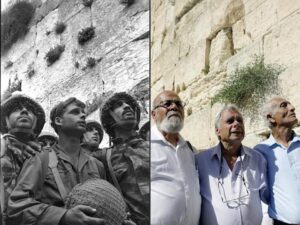
And the lesson here? Seemingly Yichus counts for something, sometimes even a lot. Ober adds the Ois azoy: one’s own yichus is key. A person is rewarded for his own achievements, not those of his father’s or his sons. A guiding principle that we were always taught in yeshiva and elsewhere is that a talmid chochom who is a mamzer (illegitimate son), is more important than a Kohain Godol who is an Am HaAretz (ignoramus). And the bottom line: when it comes yichus and being counted, it’s best to make your own. Case closed!
A gittin Shabbis and a gitten Yom Tov!
The Heylige Oisvorfer Ruv
Yitz Grossman
